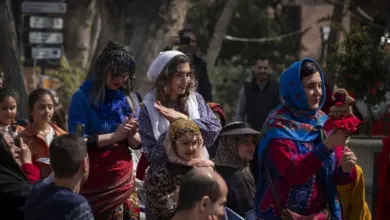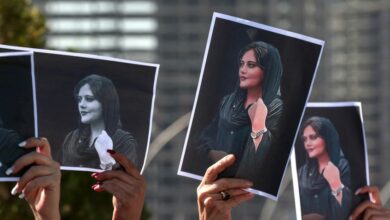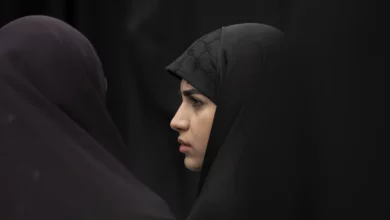Pundits and scholars don’t seem to grow tired of discussing the increase in religiosity in Egypt over the past couple of decades. The most visible evidence of this development is in the spread of the hijab among Muslim Egyptian women.
“It’s become sort of a national dress,” said Madiha el-Safty, a sociology professor at the American University in Cairo. She estimates that 90 percent of Egyptian Muslim women now wear the veil. “I often find myself the only unveiled woman in the room.”
But the hijab’s takeover of modern Egypt isn’t as monolithic as it might seem. Just below the surface, a modest backlash is brewing regarding that piece of cloth and all it has come to symbolize.
“We have a problem, I think, when it comes to the veil. There is confusion,” said Amy Mowafi, the managing editor of the society and fashion magazine Enigma. “There’s some weird stuff going on.”
The focal point of much of that “weird stuff” seems to be among Egypt’s elite. Several high-end Cairo bars and restaurants that serve alcohol essentially ban veiled women from entering. The policy is more flexible in some places than others, but seems to exist in at least half a dozen Cairo venues.
Al-Masry Al-Youm staffers personally witnessed veiled women recently being turned away at the door of downtown’s After Eight and being told they couldn’t sit in the bar or lounge area at Zamalek’s La Bodega because of their hijab.
“They always give you the ‘There’s going to be alcohol’ reason,” said a Western-raised, veiled Arab woman. “It’s unclear what their issue is. Are they upholding their prestige or are they protecting my morality?”
The woman, who has lived in Cairo since 2006 and who requested anonymity, said she ran into this practice last year while making reservations over the phone at Sequoia, a popular Zamalek waterfront restaurant.
“The guy on the phone asked ‘Do you wear the hijab,” and told her it would be inappropriate for her to sit in an establishment where beer was being served, she said. After a bit of debate, she gave up. (Efforts to contact Sequoia management for comment were unsuccessful, but young veiled women were seen eating there as recently as last month.)
The establishment of these unofficial hijab-free zones highlights a curious sub-current in Egypt’s well-documented drift toward religion. A prominent segment of the population is deeply mistrustful of the increase in veiling and is alarmed by its spread. Feeling besieged, this segment seems willing to accept and even embrace the kind of steps that would prompt a discrimination lawsuit and cries of Islamaphobia if they were attempted in the US or Europe.
“Our relationship with religion has become so schizophrenic and love-hate,” said Ethar El-Katatney, a young veiled journalist and regular contributor to the Muslima Media Watch website, which tracks global issues relating to Muslim women. “We’re actually more judgemental to muhajjabat than they would be in the West.”
Depending on who you ask, the ban at bars is either to protect muhajjabat from “sinful” environments or to protect the regulars from having to look at veiled women.
“If you choose to be in club and drink, you don’t want to sit next to someone sending a message that all of this is haram,” Mowafi said. “Club owners have a responsibility to make sure their clients are comfortable. It’s the same as having the music too loud or serving crappy drinks.”
Several club owners and patrons, when asked about the issue, questioned why someone who is truly devout would want to be in a nightclub or bar in the first place.
Nayrouz Abuzid, who recently helped manage the popular nightclub Purple, put it this way: “I don’t see anything wrong with a veiled woman wanting to have fun. But I do think it’s a little weird for a veiled woman to be wanting to get into a nightclub that doesn’t even open until 10:30 PM.”
But the fact remains that some veiled women do want to enter these places. Abuzid said she has received, “very angry and very offended” calls from veiled women who were denied access at the door of her club. When the popular band Wust El-Balad played recently at the outdoor theater in Al Azhar park, the audience was full of young muhajjabat, some of whom were dancing. Those same fans probably couldn’t attend the band’s regular performances at After Eight—at least not without a healthy debate at the door.
Some hijabs are apparently more acceptable than others. The young muhajjaba who tried to make a reservation at Sequoia last year recalls her telephone debate with the manager taking a slightly surreal turn.
“Suddenly the guy asks me, ‘OK, do you wear it normally or in the Spanish style,’ ” she said. “Spanish hijab” is the local term for tying the scarf behind the head, leaving the neck exposed.
“The idea is that a girl who wears it is more relaxed about her religion,” the woman said.
The issue of a no-hijab door policy, some say, reveals a deeper societal polarization that extends into Egypt’s media and entertainment spheres and speaks to the country’s perception of itself. Katatney, who first put on the veil at age 13, points out that although the vast majority of adult Muslim women in Egypt are veiled, that reality isn’t represented on television or movie screens.
“If you see [a muhajjaba], they’re either from the countryside or are older women,” she said. “Even in the commercials, it’s only the ones on the Dubai-based satellite channels where you have the young veiled mothers.”
Indeed portrayals of “normal” muhajabat in Egyptian movies are so rare that each role prompts its own sociological debate about its meaning. Several years ago the movie Sahar el-Leyali (Sleepless Nights) became a surprise hit and a social phenomenon for its controversial depictions of drug use and premarital sex. But one of the most unprecedented aspects of the movie was a pregnant muhajjaba. The character, played by Mona Zaki, is a young upper-class mother, whose religion is treated as incidental and who doesn’t hesitate to kick out her philandering husband. The veil is not the center of her life. Some of her closest friends aren’t veiled and it’s simply not an issue.
In a 2003 interview, the movie’s director Hani Khalifa said he had “no goal except to be real.” Gesturing over his shoulder to a crowded Zamalek coffeeshop, he said, “You see the young woman sitting behind me? She’s veiled, and she’s sitting in a coffeeshop holding hands with a guy and it’s normal and it’s real. The people want reality. They want stories, and they want to laugh and cry and be scared. But they want it to be real.”
Despite the film’s success, it didn’t lead to a wave of similar portrayals, though there has been a slow trickle of muhajjaba roles. The recent film 1-0 featured a young veiled nurse, who disapproves of her sister sleeping her way into the music business and embarks on a disastrous flirtation with a young man. But Katatney said she felt the character, “wasn’t really well-rounded.”
People on both sides point out that the back-and-forth over the hijab may have as much to do with class dynamics as social religious anxieties.
“I’m sure there’s an element of class warfare,” said Mowafi, the magazine editor. “It’s a remnant of the old days when the hijab was considered low-class.”
Katatney said Egypt’s elite, westernized classes traditionally regarded such overt piety as the province of the lower and middle class. That changed in the last 15 years for a number of reasons, among them a crop of newly wealthy Egyptians who made their fortunes in the Gulf and returned with Wahabbi-influenced interpretations of Islam. The recent rise of populist preacher Amr Khaled drew so much attention partially because his pro-hijab message spread so quickly among Egypt’s elites. He is credited (or blamed) for almost single-handedly sparking a wave of veiling among upper-class Egyptian women.
“We want to be like the West and the hijab is regarded as a throwback—something that’s dragging us backwards,” Katatney said. “It’s just a piece of fabric. But you might as well have put a mountain on your back for all the baggage and perceptions that come with it.”




